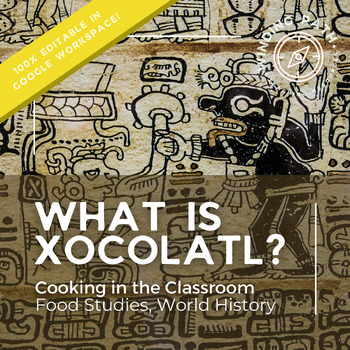Aztec & Mayan Lesson | Xocolatl Station Rotation History of Chocolate
- Google Drive™ folder

Description
In this engaging and memorable Aztec and Mayan lesson, you and your students will recreate the ancient Mesoamerican hot chocolate drink, Xocolatl! And beyond that, they will strengthen their understanding of global foods and four essential historical concepts, including cultural diffusion, social hierarchy, historical perspective, and change and continuity over time. Students will rotate between preparing and analyzing the drink (an easy, classroom-friendly recipe is included!) and choosing between four other stations where they will use xocolatl to exemplify those four essential historical concepts.
Looking for a way to jumpstart your unit about the Aztecs, Maya, and Incas and give students an experience they won't soon forget? Bring Mesoamerican culture to life in your classroom by making and drinking xocolatl!
This lesson can build on any established unit on Mesoamerica, the empires of the Aztecs, Mayans, and Incas, colonization of the Americas, or the Columbian Exchange. Or it's a great way to add a robust historical component to your global foods course. It's a great, easy-to-implement addition to add spice (literally!) to your curriculum.
The Value in Your Classroom:
- Engagement: Not only do you get to recreate an ancient Mesoamerican drink with your students, but even when they are working on their stations, they get the benefit of choosing the stations they examine and the pace they work at.
- Easy preparation: Just print it or load it to your learning management system and you're ready to teach!
- 100% editable: Everything your students will see is editable in Google Workspace, so if you want, you can modify it to the specific needs of your students.
- Connections to Your Curriculum: The students use xocolatl as an example in four large historical trends that you already teach! So this lesson can serve as a fantastic preview, review, or summary activity in your course.
- Save Time: This lesson has materials from start to finish!
---------------------------------------------------------------------
Here's how the lesson is structured:
- Engagement: The lesson opens with physical activity as students move around the classroom to identify the origins of foods they know and love, like sugar, chocolate, and cinnamon!
- Xocolatl Preparation Station: Every student gets a chance to help recreate xocolatl, the ancient precursor to hot chocolate! Safety posters and checks are provided to ensure students know how to handle food properly. They get guides to help them taste, analyze, and rate the xocolatl like the best food critic!
- Four Choice Stations: While not preparing the xocolatl, students move at their own pace through four stations in which they connect the beverage to historical trends that help explain our current world, like how xocolatl evolved into the hot chocolate we love today! Each station has a specific deliverable students complete as evidence of their learning.
- 'History of Chocolate' Exhibit: When they are finished, students take the artifacts of their learning from the five stations to create a 'history of chocolate' museum exhibit. They write an introduction and a reflection about their learning for the exhibit, which closes out the lesson.
---------------------------------------------------------------------
Here is what you get in this lesson:
- Full, detailed lesson plan with:
- Content Overview
- Lesson Objectives
- Assessments
- Suggested Lesson Procedure
- Materials List
- Differentiation and Extensions
- 1 station for preparing xocolatl, with an easy, classroom-friendly recipe, safety posters and checks, teaching guides, and student work.
- 4 carefully researched stations of historical analysis, 2 with primary sources and 2with secondary sources, which connect students' learning to larger historical trends (editable in Google Docs).
- A editable Google Slideshow that provides structure to the whole lesson, including timers to help facilitate the station rotation.
- An introductory activity to get students up and moving as soon as they enter the classroom.
- Extension activities to help your students get creative and keep learning.
- A letter to parents/guardians template explaining the lesson that comes with a permission slip (editable in Google Docs).
---------------------------------------------------------------------
If you love the idea of making fun and engaging lessons with food, check out my other Cooking in the Classroom lessons!
Looking for more Food Studies material? Check out my Food Culture Exploration! and My Food Culture Presentation Project. Or check my Food Memory Cookbook Mini-Unit:
- Introduction to Food Memories
- Food Memory Interviews
- Creating Your Recipes
- Constructing Your Cookbook
- **The Entire Food Memory Cookbook Mini-Unit Bundle**
Looking for other World History activities? Check out these great ideas:
- Child Labor Document Analysis & Letter [FREE!]
- Eulogy for the Byzantine Empire Activity
- Basics of Islam Brochure
- Spread of Islam: Architecture Gallery Walk [FREE!]
---------------------------------------------------------------------
Please let me know if you have any questions or concerns with this project, I'm happy to help! Please leave an honest review for this product, it helps both me and other teachers!
Thank you!!





